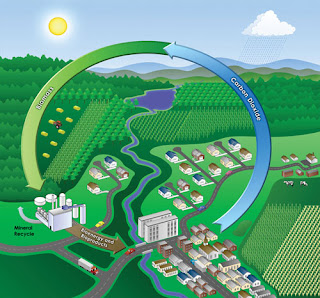Bioethanol is an alcohol made by fermenting the sugar components of plant materials and it is made mostly from sugar and starch crops. With advanced technology being developed, cellulosic biomass, such as trees and grasses, are also used as feedstocks for ethanol production. Ethanol can be used as a fuel for vehicles in its pure form, but it is usually used as a gasoline additive to increase octane and improve vehicle emissions. Bioethanol is widely used in the USA and in Brazil.
Biodiesel is made from vegetable oils, animal fats or recycled greases. Biodiesel can be used as a fuel for vehicles in its pure form, but it is usually used as a diesel additive to reduce levels of particulates, carbon monoxide, and hydrocarbons from diesel-powered vehicles. Biodiesel is produced from oils or fats using transesterification and is the most common biofuel in Europe.
Biofuels provided 1.8% of the world's transport fuel in 2008. Investment into biofuels production capacity exceeded $4 billion worldwide in 2007 and is growing.
Solid biofuels
Examples include wood, sawdust, grass cuttings, domestic refuse, charcoal, agricultural waste, non-food energy crops (see picture), and dried manure.
When raw biomass is already in a suitable form (such as firewood), it can burn directly in a stove or furnace to provide heat or raise steam. When raw biomass is in an inconvenient form (such as sawdust, wood chips, grass, urban waste wood, agricultural residues), the typical process is to densify the biomass. This process includes grinding the raw biomass to an appropriate particulate size (known as hogfuel), which depending on the densification type can be from 1 to 3 cm (1 in), which is then concentrated into a fuel product. The current types of processes are pellet, cube, or puck. The pellet process is most common in Europe and is typically a pure wood product. The other types of densification are larger in size compared to a pellet and are compatible with a broadrange of input feedstocks. The resulting densified fuel is easier transport and feed into thermal generation systems such as boilers.A problem with the combustion of raw biomass is that it emits considerable amounts of pollutants such as particulates and PAHs (polycyclic aromatic hydrocarbons). Even modern pellet boilers generate much more pollutants than oil or natural gas boilers. Pellets made from agricultural residues are usually worse than wood pellets, producing much larger emissions of dioxins and chlorophenols.
Notwithstanding the above noted study, numerous studies have shown that biomass fuels have significantly less impact on the environment than fossil based fuels. Of note is the U.S. Department of Energy Laboratory, Operated by Midwest Research Institute Biomass Power and Conventional Fossil Systems with and without CO2 Sequestration – Comparing the Energy Balance, Greenhouse Gas Emissions and Economics Study. Power generation emits significant amounts of greenhouse gases (GHGs), mainly carbon dioxide (CO2). Sequestering CO2 from the power plant flue gas can significantly reduce the GHGs from the power plant itself, but this is not the total picture. CO2 capture and sequestration consumes additional energy, thus lowering the plant's fuel-to-electricity efficiency. To compensate for this, more fossil fuel must be procured and consumed to make up for lost capacity. Taking this into consideration, the global warming potential (GWP), which is a combination of CO2, methane (CH4), and nitrous oxide (N2O) emissions, and energy balance of the system need to be examined using a life cycle approach. This takes into account the upstream processes which remain constant after CO2 sequestration as well as the steps required for additional power generation. firing biomass instead of coal led to a 148% reduction in GWP.A derivative of solid biofuel is biochar, which is produced by biomass pyrolysis. Bio-char made from agricultural waste can substitute for wood charcoal. As wood stock becomes scarce this alternative is gaining ground. In eastern Democratic Republic of Congo, for example, biomass briquettes are being marketed as an alternative to charcoal in order to protect Virunga National Park from deforestation associated with charcoal production.
Notwithstanding the above noted study, numerous studies have shown that biomass fuels have significantly less impact on the environment than fossil based fuels. Of note is the U.S. Department of Energy Laboratory, Operated by Midwest Research Institute Biomass Power and Conventional Fossil Systems with and without CO2 Sequestration – Comparing the Energy Balance, Greenhouse Gas Emissions and Economics Study. Power generation emits significant amounts of greenhouse gases (GHGs), mainly carbon dioxide (CO2). Sequestering CO2 from the power plant flue gas can significantly reduce the GHGs from the power plant itself, but this is not the total picture. CO2 capture and sequestration consumes additional energy, thus lowering the plant's fuel-to-electricity efficiency. To compensate for this, more fossil fuel must be procured and consumed to make up for lost capacity. Taking this into consideration, the global warming potential (GWP), which is a combination of CO2, methane (CH4), and nitrous oxide (N2O) emissions, and energy balance of the system need to be examined using a life cycle approach. This takes into account the upstream processes which remain constant after CO2 sequestration as well as the steps required for additional power generation. firing biomass instead of coal led to a 148% reduction in GWP.A derivative of solid biofuel is biochar, which is produced by biomass pyrolysis. Bio-char made from agricultural waste can substitute for wood charcoal. As wood stock becomes scarce this alternative is gaining ground. In eastern Democratic Republic of Congo, for example, biomass briquettes are being marketed as an alternative to charcoal in order to protect Virunga National Park from deforestation associated with charcoal production.



0 comments:
Post a Comment